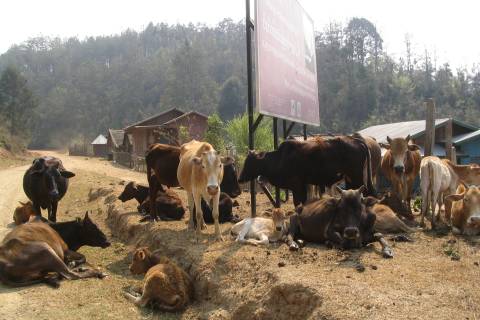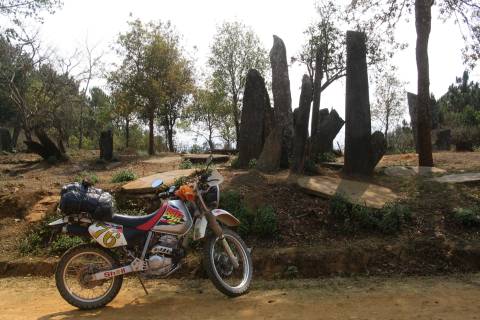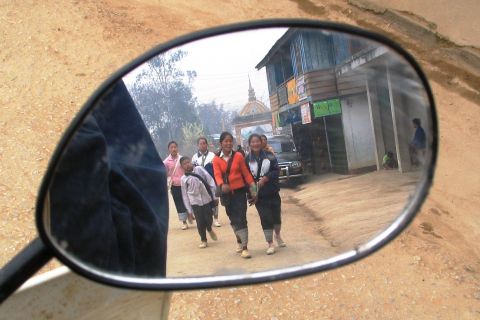Day 5 Part 2 (Xam Neua to Phonsavan)
I had wanted to visit the tourist office to get some directions to the Suan Hin (Sao Hin Tang). But the staffs were out for lunch so I decided to find the stone garden myself. There are a couple of Hintang signboards (white stone pillars on red background) on the road to direct the traveler. But the signs were not very obvious and you might find the GPS coordinates N20 07.388 E103 53.737 helpful.

Road to Suan Hin – Guarded by staring cows
No admission tickets were required for Suan Hin. When I reached the place, nobody was around – no staffs, no tourists. If it wasn’t for the huge signboard, I would have thought I had gone to the wrong place. The stone slabs might look nondescript at first but you might find them more interesting after reading the legend behind them:
In ancient times, Laos was inhabited by the Kha Yeui. Their Chief, Ba Hat, was a great giant possessing amazing powers, to whom the gods also gave three magical objects; a double-headed drum – one face struck to make enemies disappear and the other to call help from the gods; an enormous awl which pierced the stoniest ground and made water gush out; and an axe which could cut hard rock like wood.
Ba Hat felt himself no less strong than the Luang Prabang Kingdom, thanks to these marvelous instruments, so he decided the Kha Yeui were no longer subjects of the King, who soon declared war. But the victory went to Ba Hat. Later, believing the enemy kind intended to return. Ba Hat called on the help of the gods. The chief of the gods descended in person and on seeing no enemies anywhere, he flew into a rage and seized back the magical drum.
Ba Hat still had the two other tools given him by the gods. With the magical axe, he set his people out to cut blocks of stone along Nam Peun, and bear them to the top of San Ang ridge to build the new city of Kong Phanh. This aroused the King of Luang Prabang’s fears and he decided upon a ruse to keep the city from ever being founded. He succeeded in marrying his son to Ba Hat’s daughter. Misplacing their confidence in the Prince, the Kha Yeui were induced to lay the magical awl and axe onto a white-hot brazier. The two instruments immediately lost all magic power.
So the Kha Yeui had to abandon their project and they just left the stones where they had been raised up along the crest. These later on became the menhir fields of San Kong Panh and the neighboring countryside.
More on the Huaphanh Menhirs:
At least 1500 years ago, people of whose origin and fate we know almost nothing, erected hundreds of menhirs along ten kilometers of summit trails atop-forested mountains in the present Huaphanh province of Laos. Three lower saddles were favored for the main menhir fields, linked one to the next by isolated menhir clusters.
The menhirs themselves – in the form of long and narrow blades – are plaques of cut schist then erected upright, one behind the other, with the tallest often in the middle. Interspersed among the groups of menhirs, in no discernible order, burial chambers were excavated deep into the bedrock. Access to the opening below was often through a narrow vertical chimney equipped with steps. Each of these was covered by an stone disk, up to several meters in diameter.
In 1931, the sites around San Kng Phanh were surveyed and partially excavated by a team from (blank), led by archaeologist Madeline Colani. By the time she got there, the chambers contained, for the most part, nothing bu alluvial clay which had gradually washed into the cavities. It appears that they had been originally occupied by several individual burials separated yb low walls of schist plaques. Very few artifacts were recovered by the Colani expedition, apart from rather rough funerary urns; certain objects in stone, evidently ceremonial; hanging pendants in crude ceramic, and several very simple bronze bracelets.
Until the present time, these menhirs and round-lidded tombs have held onto their secrets. Perhaps those many be revealed in the coming generations.

Suan Hin (Sao Hin Tang)
I left Suan Hin at 230pm. It’s about 170km on Route 6 to Phonsavan, the next town on my itinerary. At Phonsavan, I checked in at White Orchid guesthouse. For just US$8, the spacious room even came with a bathtub. Dinner was settled at Nisha restaurant, an Indian eatery packed with tourists. In Laos, you can always count on finding excellent Indian restaurants in major cities and towns.

Schooling Kids at Phonsavan

Working Kids at Phonsavan

Sunset by green padi fields

wow you left the standing stones at 2.30 pm and still made it to phonsavan before dark ??…..you must have been
flying…its was a great scenic drive 8 hours for me in my car…i need to go back because after reading many stories about this area i feel i missed a few places and things…lucky i live in udon thani thailand so not so far to drive back again.
Hi Ken,
I reached Phonsavan just when the sun was about to set. Motorbikes are probably faster on the winding roads.
I would love to visit Southern Laos one day.